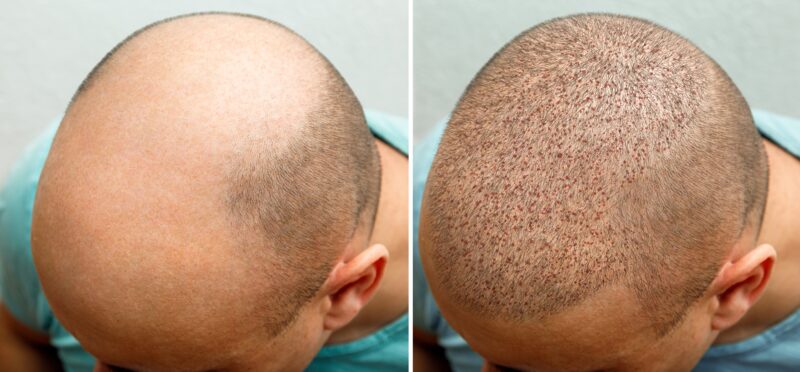Last Updated on: 17th September 2023, 12:55 pm
Hair loss is a common concern that affects millions of people worldwide, often leading to significant emotional distress and decreased self-esteem. Many individuals turn to hair regrowth treatments, in particular, hair transplantation. Hair transplantation is a type of surgery that involves moving hair follicles from one part of the body, typically the ‘donor site’, to the balding or thinning part of the body, known as the ‘recipient site’. This invasive procedure has evolved over the years into highly sophisticated techniques such as Follicular Unit Strip Surgery (FUSS) and Follicular Unit Extraction (FUE). These procedures, while effective, are also complex, time-consuming, and can be costly. They also come with their set of potential risks and expectations that should be well understood before making a decision.
On the other hand, there are non-invasive hair regrowth treatments that are often seen as more natural and less risky. These treatments can range from topical applications, like minoxidil, to the use of natural or herbal remedies such as saw palmetto or ginseng. They work by nourishing the scalp and promoting a healthier hair growth cycle, although the results may vary from person to person. Unlike invasive treatments, these non-surgical approaches are typically less expensive and have fewer side effects. However, they require patience and consistency, as visible results may take time. The choice between invasive and non-invasive hair regrowth treatments largely depends on an individual’s hair loss severity, budget, and personal comfort with medical procedures.
What is hair transplantation?
Hair transplantation is a surgical procedure designed to address hair loss, a condition affecting millions globally. This invasive treatment serves as a permanent solution for those experiencing significant hair thinning or baldness. The procedure operates on a simple principle: transplanting hair from areas of the scalp (or occasionally, other parts of the body) where hair growth is still robust, referred to as the ‘donor site’, to the areas where hair growth is deficient, known as the ‘recipient site’. The underlying philosophy is to redistribute hair follicles in a way that mimics natural hair growth patterns. This procedure is commonly used to treat pattern baldness, but it can also help improve hairline recession and fill in areas thinned by trauma or certain types of hair diseases.

Hair transplantation is not a one-size-fits-all procedure; it requires careful planning and consideration. There are two main techniques for hair transplantation: Follicular Unit Strip Surgery (FUSS) and Follicular Unit Extraction (FUE). Both have their unique methodologies, advantages, and potential drawbacks. FUSS involves removing a strip of scalp from the back of the head, from which the hair follicles are then extracted. FUE, on the other hand, involves a more meticulous process of extracting individual hair follicles directly from the scalp without removing a strip of skin. The choice between these two procedures depends on various factors, including the patient’s hair loss pattern, the size of the transplant area, cost considerations, and personal preferences regarding potential scarring and recovery time. It is essential to understand these procedures thoroughly, along with the associated risks and costs, before embarking on the journey towards hair restoration.
How do doctors perform follicular unit strip surgery (FUSS)?
Follicular Unit Strip Surgery, or FUSS, is a common type of hair transplant procedure. It is also known as Follicular Unit Transplantation (FUT) or strip harvesting. In this technique, a strip of skin with hair is surgically removed from the back or sides of the scalp, which is usually less prone to balding. This strip can be anywhere from 15 to 30 centimeters in length, and 1 to 1.5 centimeters in width, depending on the number of follicular units needed for the transplant. The wound on the scalp is then carefully closed using sutures, which leaves a linear scar that is usually concealed by existing hair as it grows back.
Following the extraction, the strip of scalp is taken to a processing unit where it is dissected under a microscope into tiny follicular units. These units are naturally occurring groups of 1-4 hairs. The dissection process is meticulous, ensuring the preservation of each follicle to maximize the success of the transplant. Once prepared, these follicular units are implanted into tiny incisions made on the recipient site, which is the balding or thinning area of the scalp. The placement of these units is done strategically to mimic natural hair growth patterns, thus promoting a realistic and uniform hair density. It is important to note that while FUSS can provide substantial coverage and high-quality results, the procedure does come with potential risks, such as scarring, infection, or numbness at the donor site, which patients must be made aware of before proceeding.
How do doctors perform follicular unit extraction (FUE)?
Follicular Unit Extraction (FUE) is a more modern and meticulous hair transplant method compared to its predecessor, Follicular Unit Strip Surgery (FUSS). FUE involves harvesting individual hair follicles from the donor area, typically the back and sides of the scalp where hair growth is still robust. Each follicle contains 1 to 4 hairs, just as in natural hair growth. This procedure is performed under local anesthesia to numb the area and minimize patient discomfort.
The process starts with the surgeon shaving or trimming the donor area. Using a specialized tool, usually a micro punch, the surgeon then carefully extracts individual hair follicles from the scalp. Each extraction creates a tiny, circular incision around a follicular unit, separating it from the surrounding tissue. The unit is then extracted directly from the scalp, leaving a small open hole. The process is repeated until the surgeon has harvested enough follicular units for the planned hair restoration. This step can take several hours and may be spread over two or more sessions. The extracted follicles are then prepared for transplantation. In the recipient area, tiny holes are created with a fine needle where the hairs are to be transplanted. The follicular units are then placed into these holes, where they will grow into healthy hair-producing follicles.
FUE is favored for its minimally invasive nature, resulting in less scarring compared to FUSS, and the potential for a faster recovery time. However, it’s essential to remember that it is a time-consuming procedure, often more expensive than other methods. As with any surgical procedure, there are risks, such as infection and scarring, and not all transplanted hair will successfully grow. It is crucial to have a detailed discussion with a qualified healthcare professional to understand what to expect from the procedure, associated risks, and costs before making a decision.
What are the risks and costs of hair transplant surgery?
Hair transplantation, while a potentially transformative procedure for those struggling with hair loss, does come with its own set of risks and costs. As with any surgery, there are inherent risks, including infection, excessive bleeding, and adverse reactions to anesthesia. Specific to hair transplant surgery, patients may experience temporary thinning of pre-existing hair, a condition known as shock loss. There’s also the possibility of unnatural-looking tufts of new hair growth or a phenomenon called ‘cobblestoning’, where the transplanted hair stands out against the natural hair. In some cases, the transplanted hair may not “take,” meaning the follicles fail to grow in their new location, necessitating additional procedures. Post-surgical pain and scarring, particularly with the FUSS procedure, are also possible.
The costs of hair transplant surgery can vary widely, primarily depending on the extent of the transplantation and the specific procedure used. In general, hair transplant cost in Singapore can range from $6,000 to $15,000. It’s important to note that most health insurance plans do not cover hair transplantation as it’s typically considered a cosmetic procedure. Additional costs might include follow-up visits, post-operative care supplies, and potentially lost wages from recovery time. Remember that while cost is an important factor, it shouldn’t be the only consideration. The surgeon’s experience, the procedure’s success rate, and your comfort with the process should also play a significant role in decision-making. It’s advisable to have an in-depth consultation with a reputable hair restoration specialist to fully understand the potential risks, benefits, and costs associated with hair transplantation.
Other non-invasive hair loss treatments
1) Visit a Tricologist
A trichologist such as regrow herbal hair treatment has alternative ways to help with hair loss and hair thinning treatments. Female pattern hair loss is sometimes caused by hormonal imbalances from menopause whilst male pattern hair loss is largely due to lifestyle and genetics. Therefore, a trichologist is trained to recognize scalp conditions and come up with a much more affordable hair loss treatment compared to having hair transplant surgery.
A trichologist will assess every aspect of your well-being and will determine the cause of your hair loss. This can be due to a lack of essential nutrients, poor dietary choices, and hygiene patterns that may add to this issue if a person suffers from a form of hair loss. A trichologist will begin treatment by performing an inspection to uncover the cause of hair loss.
This procedure is pain-free and confidential. The trichologist evaluates the scalp and hair with specialized lenses to determine the potential causes of anomalies and focuses on ways to improve the overall health of your scalp to induce hair growth. In order to get thick and healthy hair, you may be prescribed a slew of procedures.
This may include low-level laser therapy, topical agents, or prescriptions such as the regenera activa procedure or finasteride pills to return your hair follicles’ natural cycle. Your trichologist might also prescribe hair replacement therapies depending on the type of hair loss. It is important to remember that a trichologist’s role isn’t to promote a single medication or substance, but to assist you in finding the best cure for your hair loss.
2) Organic / Herbal Hair Treatment
Non-invasive hair regrowth treatments, particularly those rooted in herbal or organic formulations, are gaining popularity as alternatives to surgical procedures. These treatments leverage the power of nature to promote healthier hair and scalp, using ingredients that are typically free from harsh chemicals. Herbal treatments may come in various forms, including oils, shampoos, conditioners, and even dietary supplements. They work by nourishing the scalp, strengthening existing hair, and potentially stimulating new hair growth. Commonly used ingredients include saw palmetto, which may help block the hormone responsible for hair loss, and ginseng, which is believed to stimulate blood circulation and promote cell growth in the scalp.
One significant advantage of herbal hair treatments lies in their holistic approach to hair health. Instead of solely focusing on hair growth, these treatments often provide a wide range of benefits, such as improved scalp health, enhanced hair thickness, and increased shine. The natural ingredients used, like aloe vera, lavender, and rosemary, often contain essential vitamins, antioxidants, and anti-inflammatory properties that support overall scalp and hair health. Furthermore, these treatments typically do not contain the harsh chemicals found in many traditional hair care products, reducing the risk of damaging effects such as scalp irritation, dryness, or hair breakage. By prioritizing the overall health of the hair and scalp, herbal hair treatments can help create a more conducive environment for hair growth, leading to more resilient, healthier-looking hair over time. As part of a comprehensive hair care routine, herbal treatments can offer a gentler, more sustainable path towards managing hair loss and promoting hair health.
While herbal and organic hair treatments are generally considered safer and less costly than surgical procedures, it’s important to set realistic expectations. Results can vary greatly from person to person, and these treatments often require consistent use over extended periods before noticeable improvements occur. It’s also crucial to understand that while some ingredients may have shown promise in studies, the efficacy of many herbal treatments has not been conclusively proven through rigorous, large-scale clinical trials. Therefore, while these treatments may work well for some individuals, they may not yield significant results for others. Regardless, with their natural ingredients and lower risk profiles, herbal and organic treatments can be a worthwhile consideration for those seeking a non-invasive approach to hair regrowth.
As always, it’s advisable to consult with a trichologist in Singapore before starting any new treatment regimen to ensure it aligns with your overall health and wellness goals.






